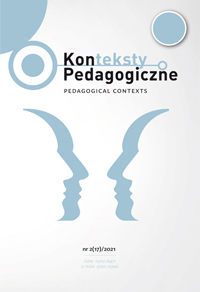Abstract
The dominant approach in children to explore holistically the world, namely to see the world in all his wholeness implies in education the need to gradually immerse pupils in perceiving various parts of the world. Hence, in educating teachers of preschool and early childhood education it is important to mention that the factor that increases the level of competences acquired in this area is to strengthen the experience in the field of visual perception and activities aimed at developing spatial imagination, which are important for understanding the legitimacy of conducting activities with children also based on spatial shaping.
As a result of the above mentioned, the research was conducted to establish the relationship between the talents of stu-dents studying in the field of pre- and early school education and the abilities to observe and code three-dimensional figures by using the language of fine art. Efforts were made to obtain answers to the question stated: What dependencies exist be-tween the skills of creating images of the observed systems of figures and the indicated talents of students. An additional problem that need to be stated was the question of determining the level of skills and abilities to create images of the observed spatial arrangements of objects by future teachers of elementary education.
Implementation of didactic tasks – as part of the basic art and technical classes conducted in primary schools, covering activities on flat compositions, but also on forming spatial figures and undertaking construction works – requires teachers to understand the importance of implementing such actions already at the earliest stages of education. Searching and applying various teaching aids supporting children’s development of the constructive sense and spatial imagination, can be of significant importance for teaching geometry at the next educational stages and for orientation in the external environment.
References
Karbowniczek, J. (2008). Zasada nauczania. W: A. Marzec, E. Sadowska i E. Piwowarska (red.), Nowe oblicza pedagogiki. Pojęcia, przedstawiciele, literatura (s. 132–133). Częstochowa: Wydawnictwo Akademii im. Jana Długosza.
Ordon, U. (2008). Funkcje i zadania nauczycieli. W: A. Marzec, E. Sadowska i E. Piwowarska (red.), Nowe oblicza pedagogiki. Pojęcia, przedstawiciele, literatura (s. 134– 137). Częstochowa: Wydawnictwo Akademii im. Jana Długosza.
Piwowarska, E. (2019). Poznawanie i rysowanie brył przez dzieci w wieku 3–9 lat – ujęcie procesualne i edukacyjne. Częstochowa: Wydawnictwo Uniwersytetu Humanistyczno-Przyrodniczego im. Jana Długosza.
Połącz kulki w figury – karty pracy – figury przestrzenne, http://bityl.pl/zRpng [dostęp: 14.01.2021].
Selvi, K. (2010). Teachers’ Competencies. Cultura. International Journal of Philosophy of Culture and Axiology, 7(1), 167–175. DOI: 10.5840/cultura20107133, https:// www.researchgate.net/publication/283961538_Teachers’_Competencies [dostęp: 15.01.2021].
Szempruch, J. (2013). Pedeutologia. Studium teoretyczno-pragmatyczne. Kraków: Oficyna Wydawnicza „Impuls”.
Śliwerski, B. (2010). Myśleć jak pedagog. Sopot: Gdańskie Wydawnictwo Psychologiczne.
In accordance with the recommendation of the Ministry of Science and Higher Education, which aims to counteract the practice of “ghostwriting” and “guest authorship,” all authors submitting their text for publication should attach an author’s statement which declares the contribution of each of the authors to the article. The printed and signed statement should be delivered by mail or other means to editor-in-chief Joanna Skibska or sent in the form of a scan to the following e-mail address: redakcja@kontekstypedagogczne.pl. The authors will not receive remuneration for publishing their papers. The editors reserve the right to make minor editorial changes to the articles which will not affect the substance of the article. We encourage all authors to prepare their articles in accordance with the guidelines for manuscript preparation. Download pdf file.
Authors transfer all copyrights and grant the journal the right of first publication with the work simultaneously licensed under a Creative Commons Attribution License that allows others to share the work with acknowledgement of the work's authorship and initial publication in this journal. All authors agree to the publishing of their email addresses, affiliations and short bio statements with their articles during the submission process.

